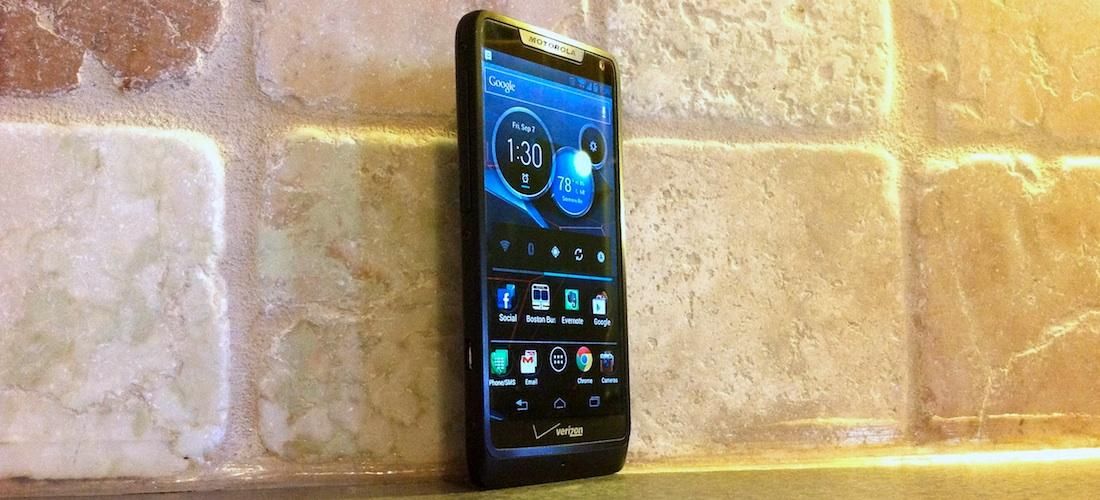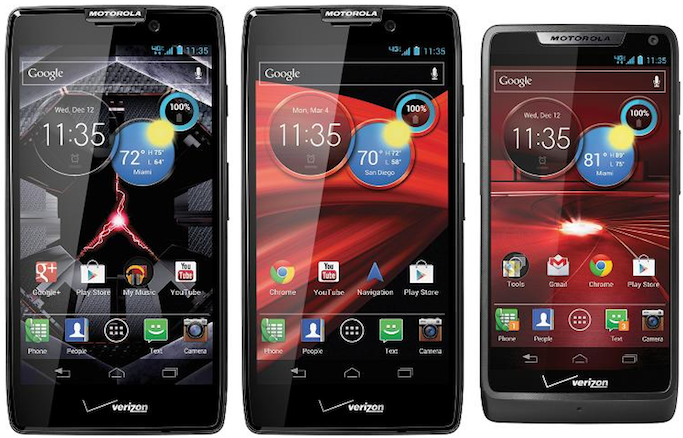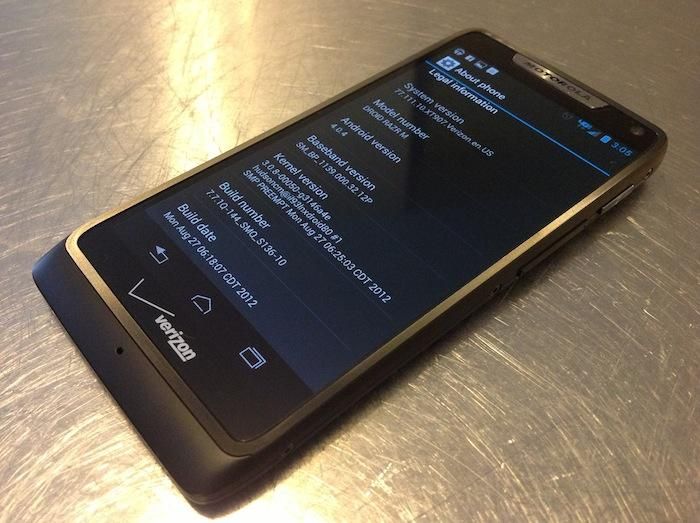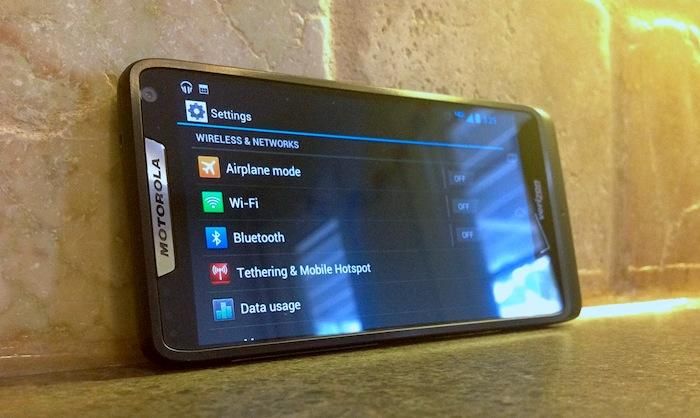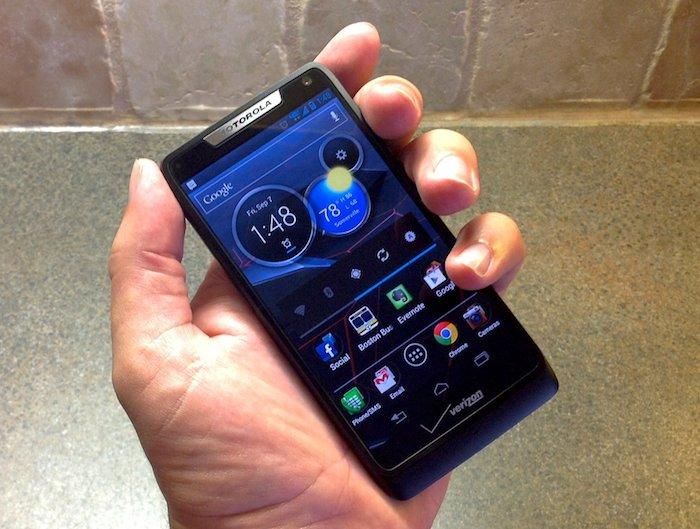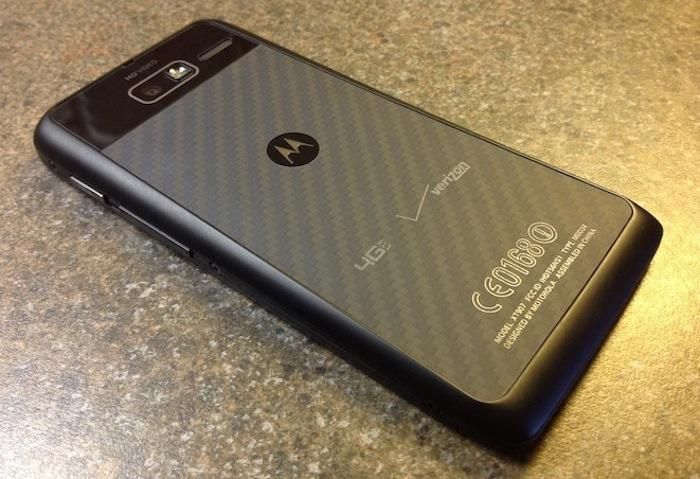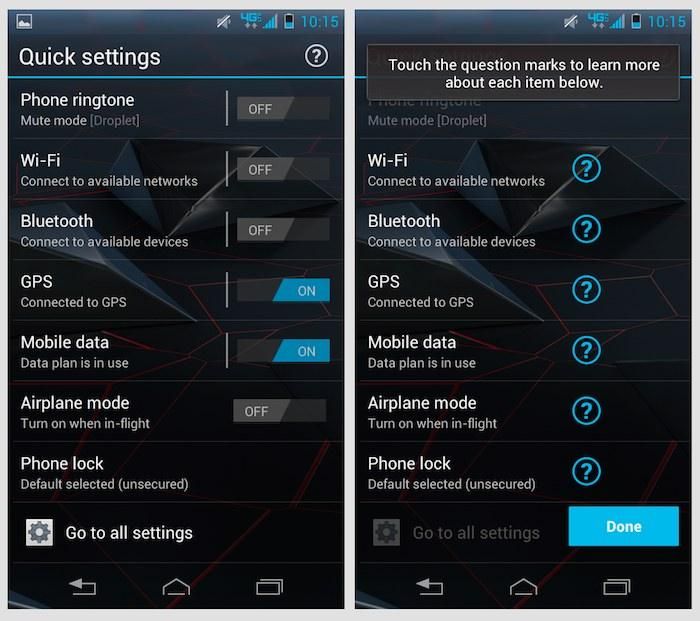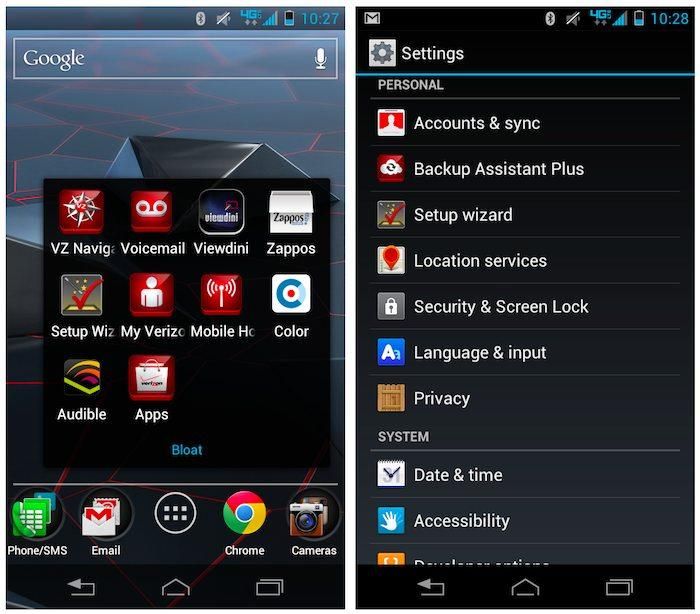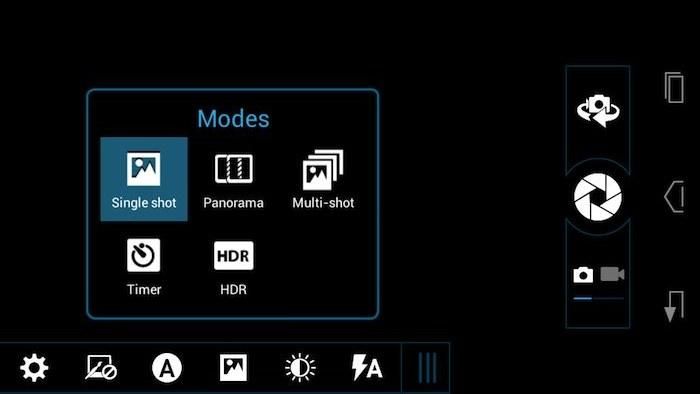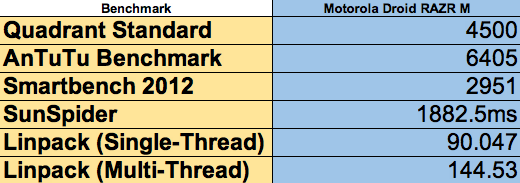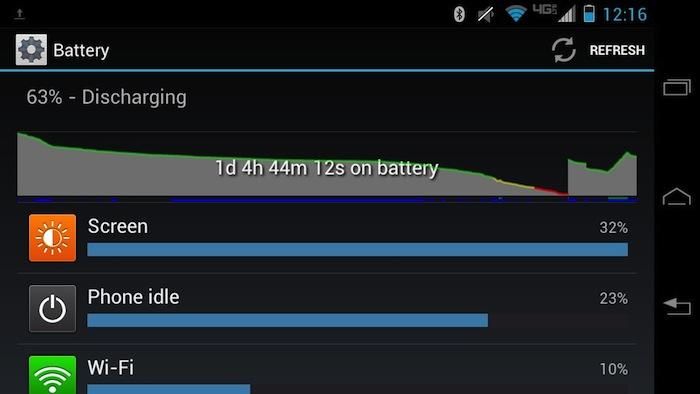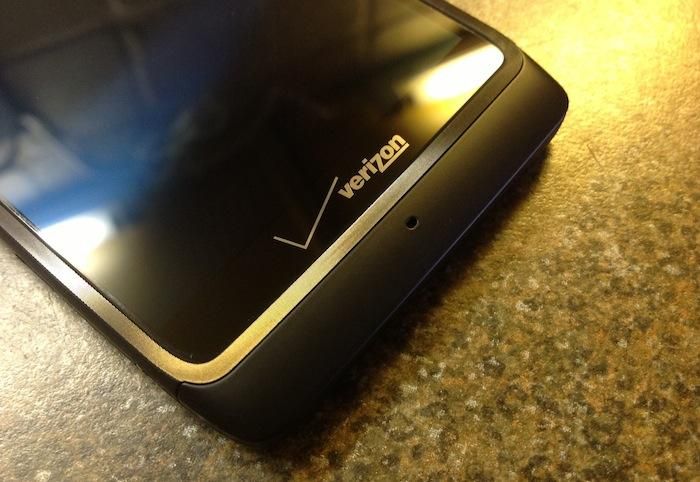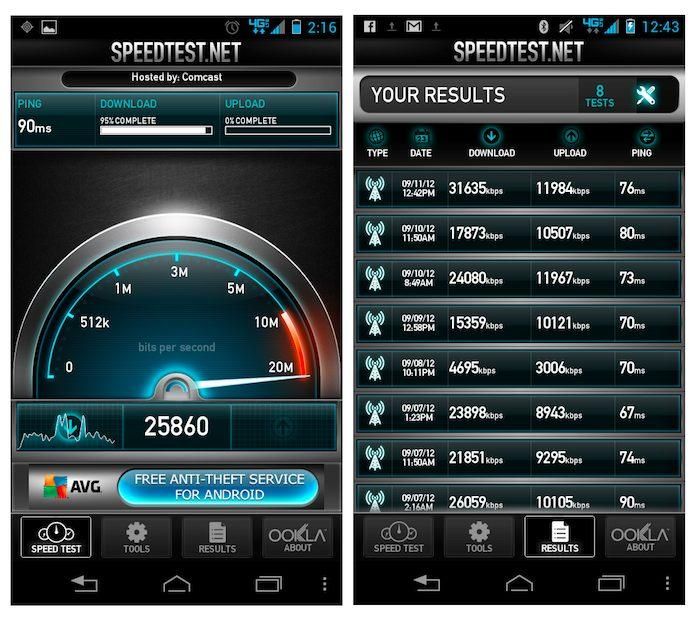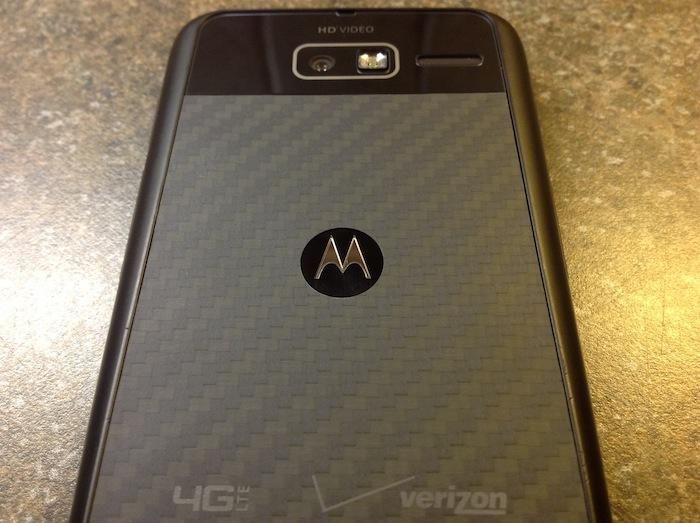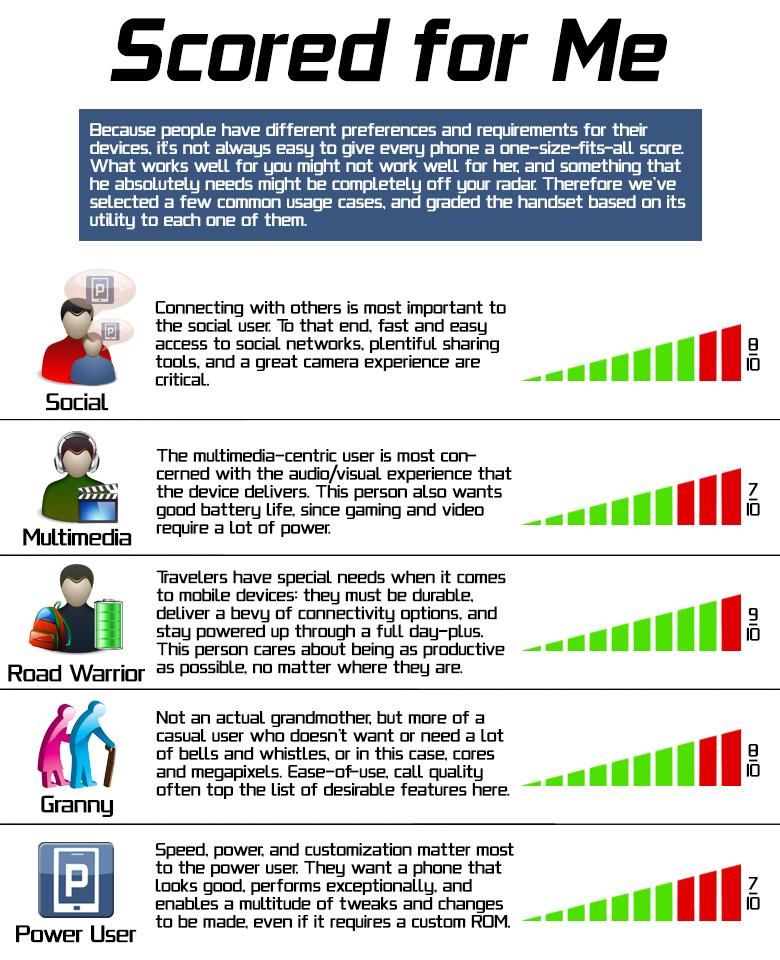Anyone following the news from last week's Motorola announcement in New York City could be forgiven for overlooking the Droid RAZR M. Alongside the Droid RAZR HD and Droid RAZR Maxx HD, the true successors to Motorola's thin-phone throne, the M seems slightly underwhelming. It's a smaller device packing a display from last year along with an unremarkable spec sheet, its casing featuring none of the aggressive visual flair of its headlining compatriots. Indeed, obscured by the glow of its larger, more-powerful cohorts, the RAZR M appears at first glance a completely forgettable device.
One of these things is not like the others.
But looks can be deceiving, and bigger isn't automatically better. We've talked before about the unfortunate tendency of manufacturers to hobble their mid-sized and smaller devices while reserving high-end components for today's jumbo-phones. While that trend shows no signs of letting up, OEMs are at least fleshing out their mid-sized offerings with devices featuring slightly more respectable spec sheets. Like the HTC Droid Incredible 4G LTE we recently reviewed, the RAZR M is a smartphone quite a bit more capable than its size would suggest.
But will that faint praise give the RAZR M enough clout to survive between its bigger brothers? More importantly, should you consider buying one? Read on to find out.
Video Review
Specs
Like many of the summer sequels crossing the Pocketnow review desk, the RAZR M wasn't built to be a powerhouse, and its spec sheet reflects that. That said, the hardware/software combo it brings to the table is thoroughly modern and just right for a mid-range Android smartphone in 2012. At the heart of it all is a dual-core CPU running at 1.5GHz; Motorola won't confirm that it's a Qualcomm Snapdragon S4 on the RAZR M's spec sheet, but we're fairly confident that's what's humming along inside the device's casing.
That's backed up by 1GB of memory on the RAM side, 8GB of storage (only about half of which is user-accessible), a Micro SD slot for up to 32GB of additional memory, and a radio package offering support for Verizon Wireless on all of its stateside CDMA frequencies. There's also support for LTE Band 13 in the U.S., as well as HSPA and GSM radios for international roaming — something we weren't necessarily expecting from a device in this price range, but which we expect to see more of as Verizon rolls out globetrotting ability to more of its device lineup. Powering it all is a battery rated at 2000 mAh, which Motorola claims is good for up to 20 hours of "mixed use." More on this later.
Some have leveled criticism at Motorola for using the same display on the RAZR M as on the original Droid RAZR: it's a 4.3' qHD Super-AMOLED Advanced panel that got its fair share of complaints on its first go-round for making use of the much-bemoaned PenTile RGBG sub-pixel arrangement. This display technology, which interleaves green pixels with red and blue ones in an alternating layout, tends to produce images of inferior quality to LCD panels of similar resolution when viewed up-close.
While we won't contest that generally accepted fact, another important consideration is how close a user's eyeballs need to get to a display to make out the difference. We've got pretty sharp eyes, and it takes us some serious focus to pick out the various pixels on the RAZR M's screen. Sure, it's evident once you start looking for it, but in our time with the device, we found ourselves more often struck by the screen's high color saturation and deep blacks, which made using the device a pleasure even in pitch-black conditions. If you're not a resolution hound or anti-PenTile crusader, the RAZR M's screen will probably serve you well.
Hardware
Motorola calls the Droid RAZR M an "impossibly compact smartphone," and while it's no HP Veer, it's definitely one of the smaller-feeling devices we've carried— especially considering its 4.3' display. It's not the slimmest at 8.3mm thin, nor the lightest at 126g, but it still manages to feel just right in the hand.
Visually, the device adheres to the new RAZR design aesthetic, but just in the barest sense. Instead of the cut corners and sharp angles of its fellows, the RAZR M is visually somewhat conservative, its casing taking the slight form of a wedge as it tapers toward the bottom. While there's no mil-spec durability rating here, Motorola has included its usual nods to toughness: Gorilla Glass 2 protects the display from scratches, while on the flip side a Kevlar micro-weave protects the non-removable 2000-mAh battery from impacts. Holding the two halves together is an aluminum frame that's often cool to the touch, and the whole shebang is dipped in Motorola's hydrophobic nano-coating to protect against water intrusion.
The design isn't totally without flair; Motorola has sprinkled a few exposed screws along the sides to emphasize the tough-guy angle, and the earpiece is elegantly hidden behind the OEM's logo above the display. Alongside that, flanking the front-facing camera, a notification LED hides in the corner. Don't get too excited, though; it only flashes when the device's battery is low.
All things considered, you won't be buying the RAZR M for its looks, but it's not entirely function-over-form. Though it hasn't crafted a stunning looker, Motorola has gone to a lot of trouble to avoid "phoning it in" with this smallest RAZRs design. The result is an unassuming phone that might look unremarkable from afar, but whose high quality and solid workmanship become evident the minute it's put into the hand.
UI
We haven't heard much from official channels on the progress of Motorola's integration into its new Google family, but some clues can be found in Motorola's custom Android skin, which seems to get thinner all the time. The app-preview popovers we liked on the Atrix HD and Photon Q are nowhere to be seen here (sad-face), and though the stock system keyboard is still called "Motorola Input," it's now so close to the stock ICS experience that it might as well be called identical ( *extremely overdue * smiley-face).
That said, some tweaks to the RAZR M's Android 4.0.4 build are still in evidence. The custom lock screen, with its four quick-jump shortcuts arranged in a circle, adds convenience and does what it can to compensate for the lack of a dedicated camera key. There's also a new homescreen layout, with the primary "anchor" screen now placed all the way to the left of the ribbon, and add-on panes expanding onward to the right. This new configuration has allowed Motorola to install a persistent "Quick Settings" panel, always accessible from the main home screen via a swipe to the right, with useful toggles for WiFi, Bluetooth, GPS, and the like, as well as a shortcut to the full settings menu. While users have always been able to add this functionality to Android via widgets, it's nice to see such a handy feature included right out of the box.
Of course, this being a Verizon Wireless device, and a high-profile "Droid" phone at that, there's no chance of the OS getting too close to stock. Big Red has loaded the phone with more than its fair share of bloatware. That's no surprise, considering its recently-renewed commitment to preinstalled apps, but it's no less annoying here than on any other device. Especially considering how poorly Verizon's Backup Assistant Plus got along with our Macbook Air here in the office.
Our test unit is running a pre-release build of the RAZR M's software, so it's unclear whether the few bugs we've run into during our testing will survive once the device hits store shelves. Thankfully, those bugs are few in number, usually taking the form of occasional stutters, and none of them have proved more than a minor annoyance.
Camera
The RAZR M bears quite a few pleasant surprises, but perhaps none are more welcome than its camera. The device's 8MP primary shooter won't win any awards, to be sure; a narrow field of view and finicky white balance are issues common to most smartphone cameras, and they're just as present on the RAZR M. But Motorola has finally, mercifully included some software tweaks here that improve the shooting experience. Chief among them: support for high-dynamic range photography, better known as HDR.
Cue long sigh of relief.
Sure, professional photographers will say it's a cheap software trick, and it sometimes results in photo subjects taking on an otherworldly glow or a washed-out look, but the aforementioned white-balance issues common to smartphone cameras make the inclusion of HDR almost compulsory these days. With its help, shadows change from dark patches of murky nothingness to defined regions of color and clarity, and blown-out expanses of bright white blankness reveal their details. The viewfinder will even suggest enabling HDR if you're trying to shoot a scene with too great a differential between light and dark regions; it's a little aggressive sometimes, but it's a nice touch.
Standard on the left, HDR on the right.
Colors sometimes appear slightly washed out, and dimly lit environments are a challenge as always, but otherwise, camera performance is on par with other mid- to high-end smartphones. The app launches quickly, there's not much shutter lag, and tap-to-focus is alive and well.
For the sake of completeness, we should mention that the strange audio bug we encountered on the Atrix HD and Photon Q is still here: if you're listening to music through your headphones and snap a photo, the speakerphone will blare out a half-second's worth of whatever song you're enjoying, while your headphones blast you with an earsplitting shutter sound. It was an oddity the first time, an annoyance on the second go-round, and now it's just plain irritating. We don't have the problem on our Samsung Galaxy S III, and it never arose on our Galaxy Nexus, so it's not a problem common to all Android devices. It would be really nice if Motorola fixed this problem.
As with the Photon Q, videos shot with the Droid RAZR M come out quite nicely. Color reproduction is good, auto-focus reasonably quick, and even white balance auto-correction is within acceptable limits. There are a few custom shooting modes, including some handy noise-cancellation features for the often-overlooked audio side of the equation.
Performance
The mid-tier Droid RAZR M obviously isn't built to be a spec hog. That said, it keeps pace nicely with other devices in its class, besting the similarly-specced Photon Q and even the Sprint Galaxy S III in some categories. Motorola's inclusion of Google Chrome as the stock browser probably helps out the phone's SunSpider performance when compared with stock browser scores on other devices.
Back on-device, the dual-core 1.5GHz CPU delivers enough horsepower to run low-demand games like F-18 Carrier Landing just as well as any other device, though hardcore gamers might have trouble running more elaborate titles. With the bevy of higher-end, larger-screen devices available, though, it's hard to see why a gamer would choose the Droid RAZR M as his or her daily driver.
Click for full-size.
Battery Life
As we mentioned before, Motorola is quoting a new-ish figure in its battery performance claims for the Droid RAZR M, something called "mixed use." The company defines this as "an average user profile that includes both usage and standby. Actual battery performance will vary and depends on signal strength, network configuration, features selected, and voice, data and other application usage patterns."
If you ask us, this makes a lot of sense. "Talk" and "standby" times for mobile devices have grown less and less relevant as focus has increasingly shifted away from voice calls toward data-centric applications. "Mixed use" is exactly the kind of usage we subject our phones to here in Pocketnow's Boston offices, and the RAZR M endures it quite well. Even without using any of Motorola's power-saving Smart Actions, the 2000-mAh battery lasted us well over a day in a usage pattern that included an overnight's worth of standby, lots of social media browsing and background polling, about 100 SMS messages, the same number of emails, two hours of Google Play music listening, a smattering of photos and videos, and a handful of phone calls. That's while the device was connected to LTE.
Average users should have no problem getting through a full day with the RAZR M, and even those who forget to plug it in overnight should at least be able to make it through the morning commute before needing to recharge.
Call Quality/Network Performance
We've been testing the Droid RAZR M in the Greater Boston area, where Verizon Wireless' 4G LTE coverage is nearly ubiquitous. Performance has been almost universally excellent. Callers say we sound fine, and they come through loud and clear over the device's earpiece. Motorola's noise cancellation technology does as good a job here as it did on the Photon Q, though there weren't any squadrons of motorcycles around this time to test how its background-noise mitigation compares with the Atrix HD's. Speakerphone performance is, as always, a little raspy, but there's less tinniness with the RAZR M's speaker than we've heard from other devices. It's a shame the speaker doesn't do quite as good a job with calls as it does when playing media, something that sadly seems par for the course with smartphones these days.
On the data front, the phone screams. Verizon's LTE data speeds combine with the newly optimized Google Chrome to deliver an excellent browsing experience. As with most Motorola devices, reception is excellent, even managing to hold onto a connection in some notoriously unreachable sections of Boston's MBTA subway system. Speeds vary depending on what we assume are network loading conditions, but we're averaging between 15-20Mbps down and around 10Mbps up— more than enough even for data hogs such as ourselves.
Pros
- Durable, robust hardware
- Very good battery life
- Close-to-stock Android experience
- Great data speeds and voice clarity
- Improved camera over other Motorola offerings
Cons
- Underwhelming industrial design
- Non-removable battery
- No Jelly Bean on board
- PenTile display matrix will irritate some
Pricing and Availability
The Droid RAZR M will hit store shelves at Verizon Wireless shortly, launching September 13 for a subsidized price of $99 with a two-year contract.
Conclusion
It's sometimes hard to get excited about the mid-range smartphones, that legion of under-appreciated workhorses keeping the cost-conscious buyers afloat, one two-year contract at a time. Too often, the devices filling this segment of the landscape reek of compromise, with last year's components stuffed inside an unremarkable casing bearing the unmistakable stench of mediocrity.
We're happy to say that's not the case with the Droid RAZR M. While its appearance might lack the ambition of its pricier compatriots, it's still a sharp-dressed device that never gets close to looking frumpy. And while its display might be from 2011's parts bin, it's coupled with a powerful processor, ample RAM, a very nice software load, and enough battery life to make it through a day — and all at a price point sure to make everyone from students to moms to old-timers happy.
In short, the Droid RAZR M is a mid-range device that does its high-end brand name proud. If you're in the market for a reasonably-priced Android smartphone with high portability and good performance, this device should be near the top of your short list.

